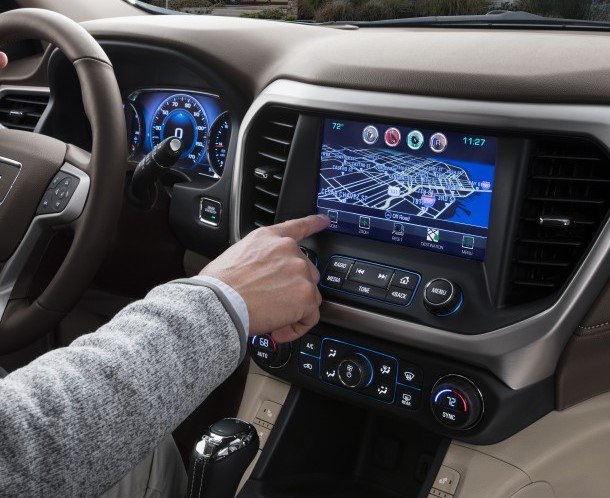Scary Stats: Drivers Don't Know Jack About the Tech In Their Car

Over the weekend, I found myself conversing with a young woman who admitted to being slightly creeped out by modern automotive technology. She had a bone to pick with everything from push-button ignitions to adaptive cruise control. It was surprising admission from an individual who is planted squarely in the middle of the Millennial age bracket and has no serious interest in cars, but one I’ve been hearing more often lately.
The American Automobile Association seems to be rather touchy on the issue, as well. Much of its interest in the subject revolves around present-day tech lending itself to distracted driving, something it is firmly against. But the AAA Foundation for Traffic Safety appears absolutely convinced that the introduction of advanced driver assistance systems will save lives. However, it also believes that its full potential won’t be unlocked until consumers accept these technologies, understand how to use them, use them as intended, and avoid misusing or becoming over-reliant on them.
Frankly, that sounds like wishful thinking. So long as advanced driving aids exist, they’ll probably be misunderstood and misused. People don’t even use their turn signals correctly, for Christ’s sake.
We seem to be living in an era where technology has outrun the general public’s ability to comprehend it. Yes, it probably feels that way no matter which year you’re living in. But when I launched into an extravagantly dull diatribe on driving aids and semi-autonomous vehicles, the woman’s eyes widened. “I didn’t know about all of that,” she said. “It’s kind of scary that the car is in charge of so much.”
She then asked me how we ensure automakers intuitive produce systems that won’t fail us. I didn’t have a good answer, as there really isn’t one. The Department of Transportation and the National Highway Traffic Safety Administration don’t seem overly interested in regulating new technologies and there’s no federally mandated driver’s training course that incorporates them. And, if you’re hoping to get the play-by-play at a dealership, you’ll probably be the one doing the asking. You’ll still need to fortunate enough to find a salesperson who knows what they’re talking about if you want the straightest of scoops.
The best we have is the NHTSA proudly announcing that automakers have informally agreed to make automatic emergency braking standard equipment by 2022 — saving it the trouble of having to draft something it’ll just have to run by Congress, which doesn’t seem to know much about cars or technology. Meanwhile, automakers get a free pass to test out new software and hardware without much oversight.
While we can argue endless as to whether or not it’s better that way, it doesn’t help get the public informed. In a recent survey, AAA discovered a significant percentage of drivers did not even understand the tech within their own vehicles. Using a sampling of 1,380 owners of specific vehicle trims, identified as including three or more relevant technologies, AAA found that most owners trusted and were satisfied with the systems in their cars — even if they couldn’t fully comprehend it.
From the AAA Foundation for Traffic Safety:
Only 21 [percent] of owners of vehicles with [blind spot monitoring] systems correctly identified an inability to detect vehicles passing at very high speeds as a limitation of the system; the remainder expressed various other misconceptions about its function or reported that they were unsure of the system’s limitations.
33 [percent] of owners of vehicles with [automatic emergency braking] systems did not realize that the system relied on cameras or sensors that could be blocked by dirt, ice, or snow.
The survey data also offered evidence of potentially unsafe behaviors stemming from the inclusion of certain driving aids. Among the worst examples were the 29 percent of respondents who admitted to occasionally feeling comfortable enough to engage in non-driving activities while using adaptive cruise control. Another 30 percent claimed they relied entirely upon their blind spot monitoring system to change lanes, either occasionally or routinely failing to physically check their blind spot by turning their head.
If you’re not sufficiently horrified already, allow us to remind you that previous studies showed a correlation between advanced driving aids and complacency behind the wheel. They may even actively dull your ability to drive.
While I’m scrambling to offer a solution to what looks to be a rather serious issue, I am willing to concede that advanced driver assistance systems do help make terrible drivers better. But what use is that if it makes proficient drivers worse?
[Image: General Motors]

A staunch consumer advocate tracking industry trends and regulation. Before joining TTAC, Matt spent a decade working for marketing and research firms based in NYC. Clients included several of the world’s largest automakers, global tire brands, and aftermarket part suppliers. Dissatisfied with the corporate world and resentful of having to wear suits everyday, he pivoted to writing about cars. Since then, that man has become an ardent supporter of the right-to-repair movement, been interviewed on the auto industry by national radio broadcasts, driven more rental cars than anyone ever should, participated in amateur rallying events, and received the requisite minimum training as sanctioned by the SCCA. Handy with a wrench, Matt grew up surrounded by Detroit auto workers and managed to get a pizza delivery job before he was legally eligible. He later found himself driving box trucks through Manhattan, guaranteeing future sympathy for actual truckers. He continues to conduct research pertaining to the automotive sector as an independent contractor and has since moved back to his native Michigan, closer to where the cars are born. A contrarian, Matt claims to prefer understeer — stating that front and all-wheel drive vehicles cater best to his driving style.
More by Matt Posky
Latest Car Reviews
Read moreLatest Product Reviews
Read moreRecent Comments
- Doug brockman There will be many many people living in apartments without dedicated charging facilities in future who will need personal vehicles to get to work and school and for whom mass transit will be an annoying inconvenience
- Jeff Self driving cars are not ready for prime time.
- Lichtronamo Watch as the non-us based automakers shift more production to Mexico in the future.
- 28-Cars-Later " Electrek recently dug around in Tesla’s online parts catalog and found that the windshield costs a whopping $1,900 to replace.To be fair, that’s around what a Mercedes S-Class or Rivian windshield costs, but the Tesla’s glass is unique because of its shape. It’s also worth noting that most insurance plans have glass replacement options that can make the repair a low- or zero-cost issue. "Now I understand why my insurance is so high despite no claims for years and about 7,500 annual miles between three cars.
- AMcA My theory is that that when the Big 3 gave away the store to the UAW in the last contract, there was a side deal in which the UAW promised to go after the non-organized transplant plants. Even the UAW understands that if the wage differential gets too high it's gonna kill the golden goose.


































Comments
Join the conversation
Just got a new Accord with all the fancy-schmancy tech stuff on it. I love some of the tech - adaptive cruise control is a wonder, lane assist is OK for short periods on the freeway, and automatic braking has some work left to do (for the false positives which will lead people to turn it off). In the end they're all good things but there's a time and a place for using them - and a time and place for NOT using them. At *all* times they need to be monitored. I'll use the lane assist to get a drink of water or coffee, but it's failed enough to where I'll still only do it on a straight-ish, well-marked road. In many cases this new car is harder to drive than the old one - at least mentally and more so in the beginning as I learned to use it. Experience with it has lessened that; I'm now finding it easier in most cases than my old one - although not as fun as the six-speed! But to the point of the article: This is the first car I've owned where I've actually had to read the manual - twice in some sections - so I could understand what the thing was going to do and what it was thinking about. Without reading the manual, it'd be frightening driving one of these things not knowing just what it's doing, what it's looking at, and when it's likely to fail. Knowing the majority of the public just can't be bothered is the really scary part. I'm lucky enough to fly airplanes for a living. We trust the automation, but we're trained on it and we know it can - and at some point will - fail. We're ready for it, and we practice it. These driving aids will fail more often and sometimes in unpredictable ways, and if drivers aren't ready someone will get hurt.
Complacency reduces crash rates. From a safety standpoint, it's a benefit. All of the ideas that appeal to driving enthusiasts, such as advanced driver training and more stringent license requirements, do nothing to improve safety and can even backfire. These things appeal at the gut level, but the research proves otherwise.